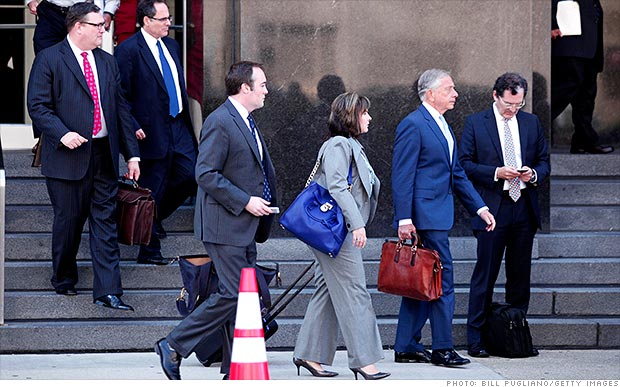Advisors told ThinkAdvisor that their hopes are fading that the Securities and Exchange Commission will release a fiduciary rule proposal during the law’s third year of life, which was ushered in on Sunday.
 “I’m becoming progressively more pessimistic, although there has been no action as of yet” by the SEC on a fiduciary rule, says Harold Evensky (right), president of Evensky & Katz Wealth Management.
“I’m becoming progressively more pessimistic, although there has been no action as of yet” by the SEC on a fiduciary rule, says Harold Evensky (right), president of Evensky & Katz Wealth Management.
However, Marcus Stanley, policy director for Americans for Financial Reform, told ThinkAdvisor on the sidelines of the Cato Institute’s event in Washington Monday titled Dodd Frank’s Third Anniversary: Has It All Been Worth It?, that large institutional asset managers like Blackrock and PIMCO should be targets by the Financial Stability Oversight Council—which was created by Dodd-Frank—to be considered as systemically important financial institutions (SIFIs).
Whether an institutional asset manager or a hedge fund will be the next SIFI designee “is a really important question,” Stanley told ThinkAdvisor, as “so far what the FSOC has done is designate those [firms that are] completely obvious as they were central to the system.”
FSOC, Stanley said, is “just only now saying GE Capital and AIG” are significant. Firms like “BlackRock and PIMCO,” he said, are two of the big institutional asset managers where “there needs to be a more serious examination” taking place as to whether they are systemically important.
MetLife was also recently put under review by FSOC to be considered to be a nonbank SIFI. But James Donnellan, VP of government relations at MetLife, noted at the Cato event that while "AIG is welcoming being a SIFI, MetLife is not." Said Donnellan: "We don’t believe the insurance industry caused the [financial] crisis."
Dodd-Frank gave the SEC the authority to create a fiduciary standard for brokers. However, the law didn’t mandate that the SEC write such a rule. Where fiduciary duty stands among the SEC’s priorities remains questionable, as the agency still has nearly 100 mandated rules to pass.
Given that the SEC has to digest new data after the July 5 close of its comment period on the costs and benefits of a fiduciary rule, as well as two new commissioners likely to take their seats at the SEC soon, industry officials predict any rule proposal from the SEC won’t come until year-end, at the earliest, with more likely bets placed on a release next year.
“This should take time,” says Knut Rostad, president of the Institute for the Fiduciary Standard, who says that a fiduciary rule proposal won’t be released until year-end at the earliest. “With new commissioners on board” at the SEC shortly “and new research data to absorb, in some key respects we are starting anew” on an SEC fiduciary rule. /* .premium-promo { border: 1px solid #ddd; padding: 10px; margin: 0 10px 10px 0; width: 200px; float: left; } .premium-promo li, .premium-promo ul { list-style-type: none; margin: 0; padding: 0; } .premium-promo li { margin: 0 0 10px; padding: 0 0 10px; border-bottom: 1px dotted #ddd; } .premium-promo h3 { text-transform: uppercase; font-size: 11px; } .premium-promo h4 { font-size: 16px; } .premium-promo a { text-decoration: none !important; } .premium-promo .btn { background: #0069a1; border-radius: 4px; display: inline-block; padding: 5px 10px; clear: both; color: #fff; font-weight: bold; } .premium-promo .btn:hover { background: #034c92; } */ The Senate Banking Committee confirmed on July 18 the nominations of Kara Stein, an aide to Sen. Jack Reed, D-R.I., to replace SEC Commissioner Elisse Walter, and Michael Piwowar, an economist on the Senate Banking Committee’s staff, to replace Troy Paredes, a Republican. The confirmations still need approval by the full Senate.
Don Trone, CEO of 3Ethos, says that on a scale of one to 10, he believes that three year's after Dodd-Frank the industry consensus on a full fiduciary standard being passed is between two and three. "That’s right, we’re backsliding," Trone says.
If asked to predict the fiduciary duty rule's future, "I’d say that the broker-dealers are going to win – and, win big," Trone says. The net result, he says, "is going to be harmonized rules which will carry the fiduciary label, but will not resemble the standard which we have spent the last 25 years building. Once there are harmonized rules, then the next step will be to subject all advisors" to oversight by the Financial Industry Regulatory Authority. "Fiduciary will no longer be a point of differentiation, and it will no longer define a higher professional standard of care," Trone says. "The Series 7 exam will have an extra 25 questions on the subject of fiduciary responsibility, and voila – everyone’s subject to a uniform fiduciary standard."
Ron Rhoades, assistant professor and chairman of the financial planning program at Alfred State College, predicts a fiduciary proposal will come in 2014. Neil Simon, vice president for government relations at the Investment Adviser Association, agrees, stating that he’s “expecting” a rule proposal next year.
However, Rhoades, too, remains skeptical that the SEC will promulgate “a bona fide fiduciary standard.” Instead, he says, based on the agency’s March 1 request for data, the SEC seems to be headed toward issuing “a watered-down fiduciary standard just requiring disclosures of certain conflicts of interest.”
According to a Dodd-Frank three-year anniversary analysis released by the law firm Davis Polk, as of July 15, a total of 279 Dodd-Frank rulemaking requirement deadlines have passed, which is 70.1% of the 398 total rulemaking requirements, and 99.6% of the 280 rulemaking requirements with specified deadlines.
---
Check out Debunking Time: Fiduciary Duty Would be Good for (a Broker's) Business by Bob Clark on ThinkAdvisor.


 Detroit tries to rise again
Detroit tries to rise again 
